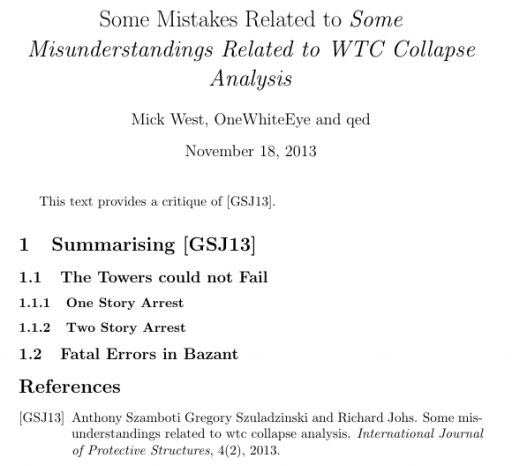I agree, Bazant got it hopelessly wrong and exaggerated velocity to support his preferred conclusion.
He did choose a drop of 1 story to initiate, but then he went back and re-figured (using his numbers) to see what the threshold would be to precipitate collapse and found a drop height value of 0.5m. That amounts to an impact speed considerably less than actual.
So it should be easy therefor to see how accurate Bazant actually was, by calculating the momentum transfer that would occur if indeed we simplify, as he did, and think about 2 blocks. In such an analysis the collapse would be arrested in one or 2 floors.
Again, it's all in whose numbers are used and in what way. The easiest way to render Bazant wrong or irrelevant is to note the actual collapses didn't conform to the model he uses. Problem is (if you're trying to show arrest), that same argument also applies to Tony Szamboti, who uses the same model. Bazant's shtick has been that his model represents a bounding case which requires the maximum energy to crush and would therefore tend towards survival as much as is possible.
We've just seen how freefall through an entire story is excessive, and I do not dispute Tony's engineering estimate which holds the as-built capacity should be considerably greater than Bazant calculated, as well the driving mass considerably less. So Bazant does NOT describe the
most optimistic case for survival, just an optimistic one. If the real collapses did not conform to these optimistic conditions, then not only is the model incapable of producing realistic expectations, we also know the expectation has to be less optimistic.
What Bazant did was try to show that it collapses even in the best case scenario. What Tony has done is show that it might not collapse in the best case scenario, after corrections to the estimates. That's not entirely useless in itself, after all, it could replace Bazant's analysis as the most conservative. What it does not do is show the structure should have survived, which is Tony's intent.
I'm a true believer in the adage "once the top starts moving, there's no stopping the collapse." That belief is not based on calculation, but not on faith, either. The problem is resolved through observing that no viable load paths emerged during the early stages of collapse which were capable of supporting the
static load, let alone dissipate the momentum of a moving load. This, of course, is the point Tony is arguing with me - his position being there HAD to be be full (or near) capacity load paths available and so the structure would arrest. The disagreement comes down to this: Must there be full capacity, or must there not be?
The motion of the upper section, even assuming the upper section to be a rigid integral unit, is not simply vertical displacement. If it were, then measuring the motion of a single point would be representative of the block as a whole. When there's displacement and rotation in multiple axes, and unknown amounts of disintegration of the unit, it becomes less so. Fortunately, the motion was predominantly vertical right after release, and it could take a while before the upper section is dissociated significantly. The closer the measurement is to the release time, the better.
Neither am I, the upper block is not actually observed to be causing damage to the building below at the start of the collapse. For what reason do you not believe that the upper block remained intact at the point at which it would be impacting that part of the building below?
I should clarify: it may have been mostly intact after the descent of one story (first impact), but likely not for long.

